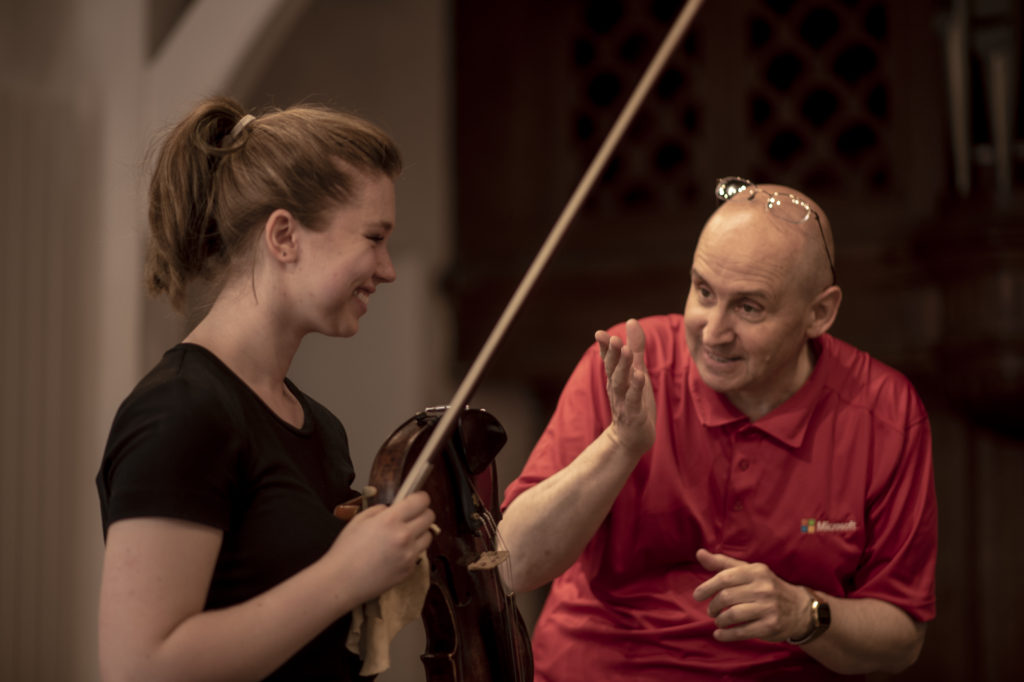July 1 – 26, 2024
in Paris



The curriculum, built upon our unique vision for the well-trained musician, includes intensive coursework in the fundamental tools of musical understanding as well as Analysis Seminars, Concerts and Masterclasses.
The students from all five divisions, Composition, Conducting, Chamber Music, and Music Education join masterclasses and analysis seminars and sing in our student chorale.
Course Descriptions
Counterpoint
Intensive classes are offered in the study of the craft of counterpoint. These classes are not style-based. Rather, the classes are designed for the study and perfection of contrapuntal principles fundamental to the control of all Western musical styles.
Species Counterpoint
This class examines the often-neglected single-line counterpoint, and the four basic species in two, three, and four voices. Exercises concentrate on the concepts of metrics, melodic control, imitation and non-chord tone usage. The majority of new students will be placed into this course. Higher levels of these courses will study all forms of polyphonic imitation, invertible counterpoint, and multiple invertible counterpoint.
Advanced Counterpoint
This class begins with the study of canonic procedures, including the study of cyclical canons, inversion canons, cancrizan canons, retrograde canons; and the study of ‘flip’ chorales, segueing into the study of fugue. Special topics concentrate on how to write the most flexible subject, what is involved in writing the appropriate answer, working out all possible procedures available in the subject such as stretto, canon, inversion, augmentation, etc. Fugal exposition, episodic writing, sequencing, modulation, middle entries and coda, as well as writing the appropriate prelude, are also studied. The class will culminate in the completion of a Prelude and Fugue for either organ or piano.
Keyboard Harmony
EAMA has created a unique approach to teaching Harmony. Nadia Boulanger firmly believed that harmony was best studied through singing and practice at the piano, beginning with the internalization of basic sequences and cadences before proceeding to the harmonization of figured basses and melodies. Through Keyboard Harmony we give you the tools that will train your ear beyond your wildest imagination. You will begin to hear in depth and discover how to develop sonority in your own music. Our classes begin with Philip Lasser’s training method for sequences and cadences. Advanced classes move onto using the famous basses and melodies of Paul Vidal and Henri Challan, both professors of the Paris Conservatory.
Keyboard Harmony I and II:
These intensive introductory classes begin with sight-singing skills through focused practice and application of all intervals. It will also work toward fluency in fixed-Do solfège and the singing and dictation of intervals, triads, basic chord progressions, tonal melodies, and scale patterns. Other skills will include fluency in the singing and dictation of intervals, triads and seventh chords, chord progressions and scale patterns. This leads to the study of the three fundamental root motions and their corresponding voice leading as well as fundamental interval singing and recognition as well as strategies for music dictations. Cadence patterns and sequence patterns are practiced and sung in relation to the above. Root position and first inversion harmonic issues involving questions of doubling, choice of soprano note, and voice distribution are closely examined.
Keyboard Harmony III and IV
These classes offer a more in-depth look into complex harmonic issues, beginning with first and second inversion, and including the study of seventh chords, ninth chords and non-chord tone treatment in harmonic realization. Extensive work is done on four-voice harmonization of melody.
Musicianship
In her famous “cours d’accompagnement” at the Paris Conservatory, Nadia Boulanger took great effort to have her students not simply know but rather truly hear and experience the knowledge they were acquiring. To that end, musicianship classes and chorale were vital counterparts to her harmony, counterpoint, and analysis classes.
Musicianship I, II, III and IV
This class will improve sight-singing skills through focused practice and application of all intervals. Class work will consist of Bach Chorale exercises in multiple clefs as well as projects sculpted for the individual’s goal. It will also work toward fluency in solfège and the singing and dictation of intervals, triads, basic chord progressions, tonal melodies, and scale patterns. We will work in fixed-DO solfège and will use treble, bass, alto, tenor, and soprano clefs. Other skills will include fluency in the singing and dictation of intervals, triads and seventh chords, chord progressions, atonal melodies, and scale patterns.
Musicianship V
Students must demonstrate fluency in reading clefs, particularly Soprano, Alto and Tenor clefs. Students work collaboratively under the instructor’s guidance toward the goal of achieving greater fluency in deciphering printed music. Emphasizing an active, hands-on approach, the sessions entail playing and singing through orchestral and choral repertoire in a variety of styles. Throughout the classes, we discuss practical ways to approach transposition, reduction, clefs, “what-to-leave-out” and other potential stumbling blocks. The course will help you establish a foundation for successful, pleasurable score-reading.
Musicianship Workshop
We are pleased to offer a Musicianship Workshop with Dr. Kyle Blaha, Ear Training faculty at The Juilliard School. Topics include melodic and harmonic dictation, sight-singing, transposition, clefs, and rhythm. Students can come at any point during the scheduled time for individualized attention in any of these areas and stay for as long as they wish. All levels are welcome.
Chorale
Nadia Boulanger insisted that music should be heard and experienced through playing and singing. Students learn masterpieces of the choral repertoire and have the extraordinary experience of singing at at the historic Val de Grace Church in Paris.
Analysis
Both Philip Lasser and Benjamin C.S. Boyle are highly renowned for their lectures in Analysis. These classes have inspired hundreds of musicians and brought them to a deeper understanding of how music is organized and created. The class is taught at two levels for the first two weeks of the program. Advanced Analysis level is for returning students only. The levels then merge for the analysis classes on major works. Taught in relation to the other courses in the program, this class studies in-depth contrapuntal, harmonic, structural and rhythmic issues in great works of Western music. (A list of the works to be studied each year is sent to enrolled students.)
